window GMC YUKON XL 2006 Owners Manual
[x] Cancel search | Manufacturer: GMC, Model Year: 2006, Model line: YUKON XL, Model: GMC YUKON XL 2006Pages: 540, PDF Size: 3 MB
Page 1 of 540
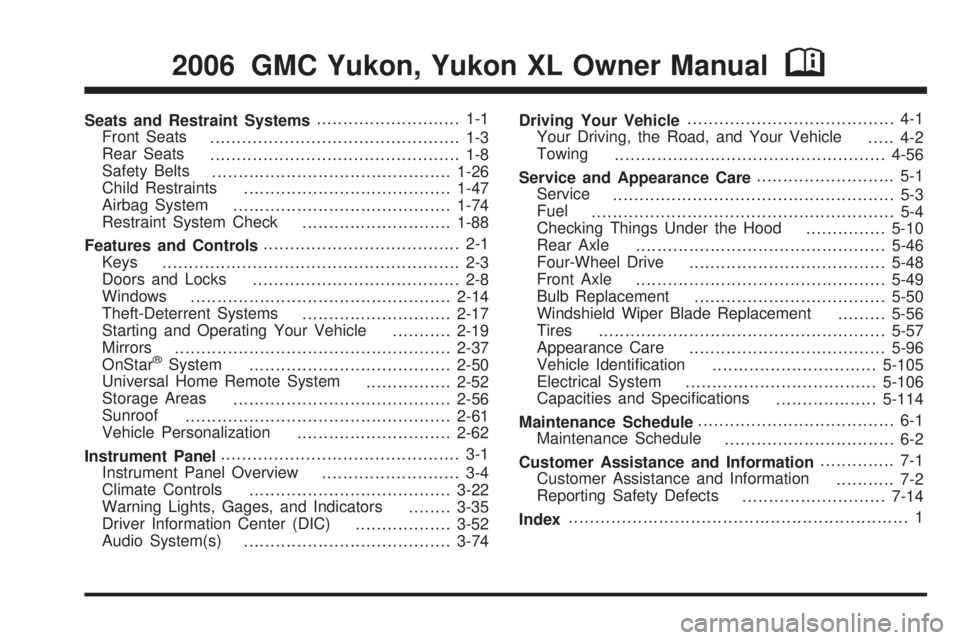
Seats and Restraint Systems........................... 1-1
Front Seats
............................................... 1-3
Rear Seats
............................................... 1-8
Safety Belts
.............................................1-26
Child Restraints
.......................................1-47
Airbag System
.........................................1-74
Restraint System Check
............................1-88
Features and Controls..................................... 2-1
Keys
........................................................ 2-3
Doors and Locks
....................................... 2-8
Windows
.................................................2-14
Theft-Deterrent Systems
............................2-17
Starting and Operating Your Vehicle
...........2-19
Mirrors
....................................................2-37
OnStar
®System
......................................2-50
Universal Home Remote System
................2-52
Storage Areas
.........................................2-56
Sunroof
..................................................2-61
Vehicle Personalization
.............................2-62
Instrument Panel............................................. 3-1
Instrument Panel Overview
.......................... 3-4
Climate Controls
......................................3-22
Warning Lights, Gages, and Indicators
........3-35
Driver Information Center (DIC)
..................3-52
Audio System(s)
.......................................3-74Driving Your Vehicle....................................... 4-1
Your Driving, the Road, and Your Vehicle
..... 4-2
Towing
...................................................4-56
Service and Appearance Care.......................... 5-1
Service
..................................................... 5-3
Fuel
......................................................... 5-4
Checking Things Under the Hood
...............5-10
Rear Axle
...............................................5-46
Four-Wheel Drive
.....................................5-48
Front Axle
...............................................5-49
Bulb Replacement
....................................5-50
Windshield Wiper Blade Replacement
.........5-56
Tires
......................................................5-57
Appearance Care
.....................................5-96
Vehicle Identi�cation
...............................5-105
Electrical System
....................................5-106
Capacities and Speci�cations
...................5-114
Maintenance Schedule..................................... 6-1
Maintenance Schedule
................................ 6-2
Customer Assistance and Information.............. 7-1
Customer Assistance and Information
........... 7-2
Reporting Safety Defects
...........................7-14
Index................................................................ 1
2006 GMC Yukon, Yukon XL Owner ManualM
Page 48 of 540

Rear Outside Passenger Positions
It is very important for rear seat passengers to
buckle up! Accident statistics show that unbelted people
in the rear seat are hurt more often in crashes than
those who are wearing safety belts.
Rear passengers who are not safety belted can be
thrown out of the vehicle in a crash. And they can strike
others in the vehicle who are wearing safety belts.
Lap-Shoulder Belt
The positions next to the windows have lap-shoulder
belts. Here is how to wear a lap-shoulder belt properly.
1. Pick up the latch plate and pull the belt across you.
Do not let it get twisted.
The shoulder belt may lock if you pull the belt
across you very quickly. If this happens, let the
belt go back slightly to unlock it. Then pull the belt
across you more slowly.
2. Push the latch plate into the buckle until it clicks.
Pull up on the latch plate to make sure it is secure.
When the shoulder belt is pulled out all the way,
it will lock. If it does, let it go back all the way
and start again.
1-42
Page 60 of 540
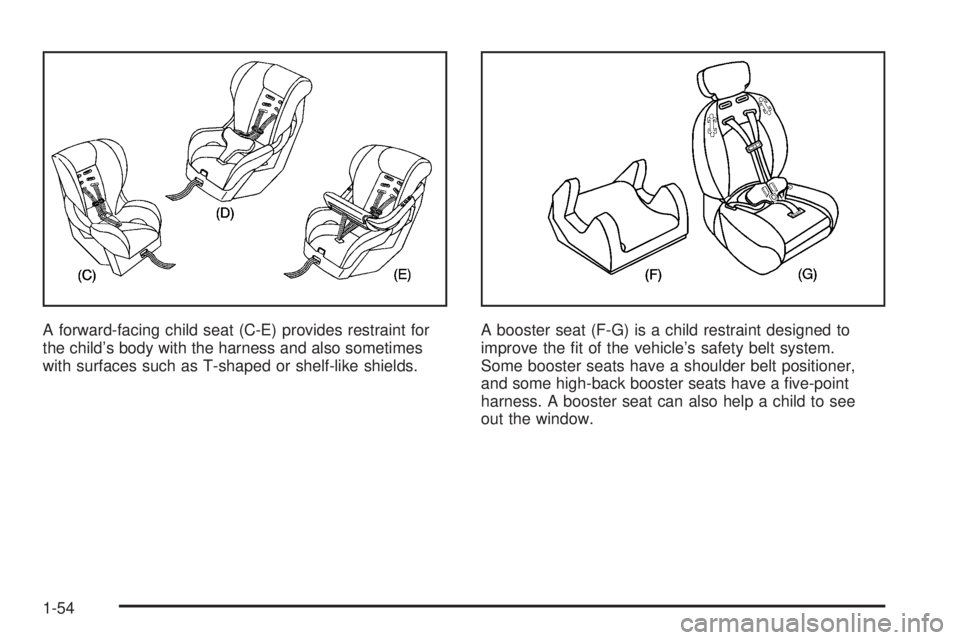
A forward-facing child seat (C-E) provides restraint for
the child’s body with the harness and also sometimes
with surfaces such as T-shaped or shelf-like shields.A booster seat (F-G) is a child restraint designed to
improve the �t of the vehicle’s safety belt system.
Some booster seats have a shoulder belt positioner,
and some high-back booster seats have a �ve-point
harness. A booster seat can also help a child to see
out the window.
1-54
Page 87 of 540

Side impact airbags would not help you in many types
of collisions, including many frontal or near frontal
collisions, and rear impacts, primarily because an
occupant’s motion is not toward those airbags. Airbags
should never be regarded as anything more than a
supplement to safety belts, and then only in moderate to
severe frontal or near-frontal collisions for the frontal
airbags, and only in moderate to severe side collisions
for vehicles with a side impact airbag.
What Will You See After an
Airbag In�ates?
After the airbag in�ates, it quickly de�ates, so quickly
that some people may not even realize the airbag
in�ated. Some components of the airbag module may
be hot for a short time. These components include
the steering wheel hub for the driver’s frontal airbag and
the instrument panel for the right front passenger’s
frontal airbag. For seating positions with side impact
airbags, the side of the seatback closest to the door may
be hot. The parts of the airbag that come into contact
with you may be warm, but not too hot to touch.There will be some smoke and dust coming from the
vents in the de�ated airbags. Airbag in�ation does
not prevent the driver from seeing out of the windshield
or being able to steer the vehicle, nor does it stop
people from leaving the vehicle.
{CAUTION:
When an airbag in�ates, there is dust in the
air. This dust could cause breathing problems
for people with a history of asthma or other
breathing trouble. To avoid this, everyone in
the vehicle should get out as soon as it is
safe to do so. If you have breathing problems
but cannot get out of the vehicle after an
airbag in�ates, then get fresh air by opening a
window or a door. If you experience breathing
problems following an airbag deployment,
you should seek medical attention.
1-81
Page 97 of 540
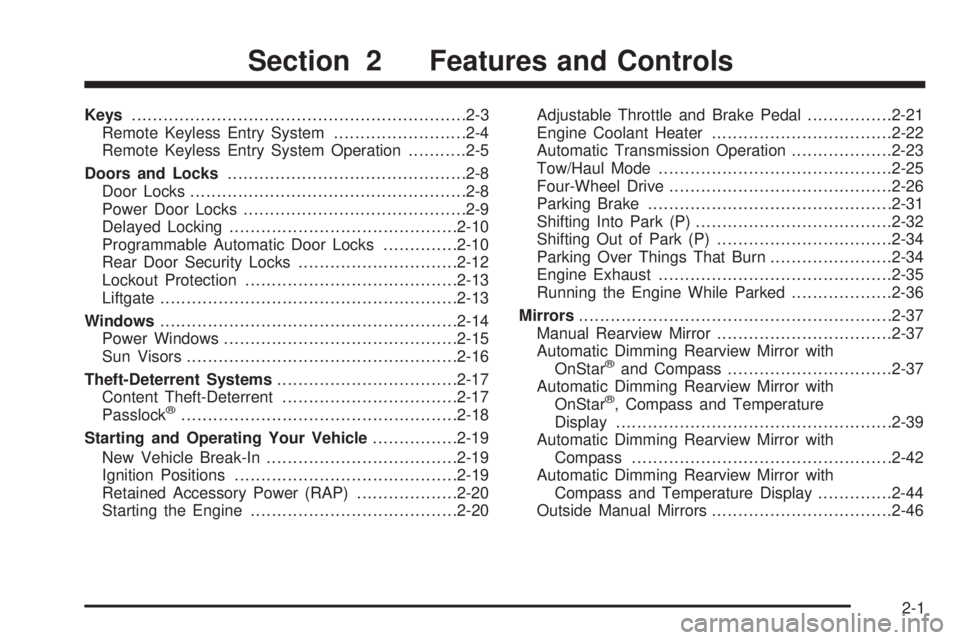
Keys...............................................................2-3
Remote Keyless Entry System.........................2-4
Remote Keyless Entry System Operation...........2-5
Doors and Locks.............................................2-8
Door Locks....................................................2-8
Power Door Locks..........................................2-9
Delayed Locking...........................................2-10
Programmable Automatic Door Locks..............2-10
Rear Door Security Locks..............................2-12
Lockout Protection........................................2-13
Liftgate........................................................2-13
Windows........................................................2-14
Power Windows............................................2-15
Sun Visors...................................................2-16
Theft-Deterrent Systems..................................2-17
Content Theft-Deterrent.................................2-17
Passlock
®....................................................2-18
Starting and Operating Your Vehicle................2-19
New Vehicle Break-In....................................2-19
Ignition Positions..........................................2-19
Retained Accessory Power (RAP)...................2-20
Starting the Engine.......................................2-20Adjustable Throttle and Brake Pedal................2-21
Engine Coolant Heater..................................2-22
Automatic Transmission Operation...................2-23
Tow/Haul Mode............................................2-25
Four-Wheel Drive..........................................2-26
Parking Brake..............................................2-31
Shifting Into Park (P).....................................2-32
Shifting Out of Park (P).................................2-34
Parking Over Things That Burn.......................2-34
Engine Exhaust............................................2-35
Running the Engine While Parked...................2-36
Mirrors...........................................................2-37
Manual Rearview Mirror.................................2-37
Automatic Dimming Rearview Mirror with
OnStar
®and Compass...............................2-37
Automatic Dimming Rearview Mirror with
OnStar
®, Compass and Temperature
Display....................................................2-39
Automatic Dimming Rearview Mirror with
Compass.................................................2-42
Automatic Dimming Rearview Mirror with
Compass and Temperature Display..............2-44
Outside Manual Mirrors..................................2-46
Section 2 Features and Controls
2-1
Page 99 of 540
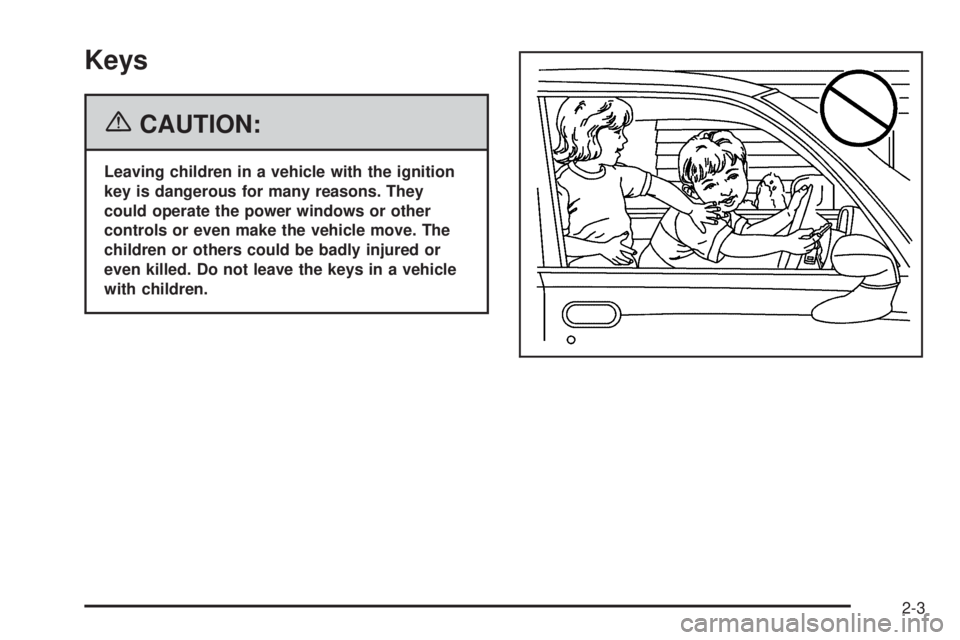
Keys
{CAUTION:
Leaving children in a vehicle with the ignition
key is dangerous for many reasons. They
could operate the power windows or other
controls or even make the vehicle move. The
children or others could be badly injured or
even killed. Do not leave the keys in a vehicle
with children.
2-3
Page 109 of 540

The rear doors of your vehicle cannot be opened from
the inside when this feature is in use. If you want to
open the rear door while the security lock is engaged,
unlock the door and open the door from the outside.
Lockout Protection
This feature protects you from locking your key in the
vehicle when the key is in the ignition and a door is open.
If the power lock switch is pressed when a door is open
and the key is in the ignition, all of the doors will lock
and then the driver’s door will unlock.
Liftgate
{CAUTION:
It can be dangerous to drive with the liftgate
glass, liftgate or rear doors open because
carbon monoxide (CO) gas can come into your
vehicle. You cannot see or smell CO. It can
cause unconsciousness and even death.
CAUTION: (Continued)
CAUTION: (Continued)
If you must drive with the liftgate glass,
liftgate, or rear doors open, or if electrical
wiring or other cable connections must pass
through the seal between the body and the
liftgate glass, liftgate, or rear doors:
Make sure all other windows are shut.
Turn the fan on your heating or cooling
system to its highest speed with the
recirculation mode off. That will force
outside air into your vehicle. SeeClimate
Control System on page 3-22.
If you have air outlets on or under the
instrument panel, open them all the way.
SeeEngine Exhaust on page 2-35.
2-13
Page 110 of 540

Liftgate Glass and Liftgate
To unlock the liftgate and liftglass from the outside, insert
the key into the liftgate lock and turn it counterclockwise.
The liftgate glass can then be opened using the button
on the liftgate. To lock, turn the key clockwise. All the
doors will lock.
To open the entire liftgate, lift the handle located in
the center of the door.
You may also use the remote keyless entry
transmitter (RKE), or the power door locks to unlock
and lock the liftgate and liftgate glass.
Windows
{CAUTION:
Leaving children, helpless adults, or pets in a
vehicle with the windows closed is dangerous.
They can be overcome by the extreme heat
and suffer permanent injuries or even death
from heat stroke. Never leave a child, a
helpless adult, or a pet alone in a vehicle,
especially with the windows closed in warm
or hot weather.
2-14
Page 111 of 540

Power Windows
The power window controls are located on each of
the side doors.
The driver’s door has a switch for the passenger and rear
windows as well. Your power windows will work when
the ignition has been turned to ACCESSORY or RUN
or when Retained Accessory Power (RAP) is active.
SeeRetained Accessory Power (RAP) on page 2-20.
Press the switch to lower the window.
Pull up the front edge of the switch to raise the window.
2-15
Page 112 of 540
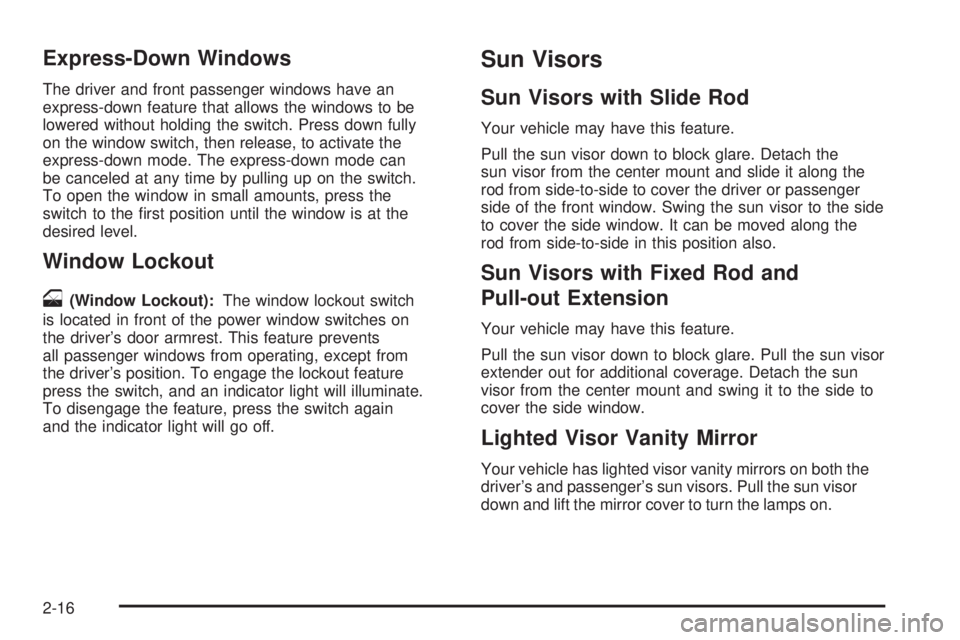
Express-Down Windows
The driver and front passenger windows have an
express-down feature that allows the windows to be
lowered without holding the switch. Press down fully
on the window switch, then release, to activate the
express-down mode. The express-down mode can
be canceled at any time by pulling up on the switch.
To open the window in small amounts, press the
switch to the �rst position until the window is at the
desired level.
Window Lockout
o
(Window Lockout):The window lockout switch
is located in front of the power window switches on
the driver’s door armrest. This feature prevents
all passenger windows from operating, except from
the driver’s position. To engage the lockout feature
press the switch, and an indicator light will illuminate.
To disengage the feature, press the switch again
and the indicator light will go off.
Sun Visors
Sun Visors with Slide Rod
Your vehicle may have this feature.
Pull the sun visor down to block glare. Detach the
sun visor from the center mount and slide it along the
rod from side-to-side to cover the driver or passenger
side of the front window. Swing the sun visor to the side
to cover the side window. It can be moved along the
rod from side-to-side in this position also.
Sun Visors with Fixed Rod and
Pull-out Extension
Your vehicle may have this feature.
Pull the sun visor down to block glare. Pull the sun visor
extender out for additional coverage. Detach the sun
visor from the center mount and swing it to the side to
cover the side window.
Lighted Visor Vanity Mirror
Your vehicle has lighted visor vanity mirrors on both the
driver’s and passenger’s sun visors. Pull the sun visor
down and lift the mirror cover to turn the lamps on.
2-16